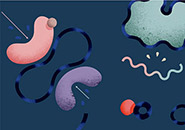
Scientific Discipline
Genetics, Medicine and Translational Research
Related Links
Host Institution
Brigham and Women's Hospital
Current Position
Dr. Seidman is also a professor of genetics and medicine at Harvard Medical School and director of the Cardiovascular Genetics Center at Brigham and Women's Hospital, Boston.
Current Research
Genetic Causes of Human Heart Disease
Research
Biography
Though no one in her family was a physician, Christine Seidman always wanted to be a doctor. But the word had a slightly different meaning for her than it does for most. "To me, that was a person who was medically trained and took care of sick people, but who also really understood why they got sick…Some people think you're a physician or a scientist. To me, they're synonymous. I still think that."
Seidman—who goes by Kricket (thanks to a young cousin who couldn't pronounce "Christine")—met her husband and research partner, Jon, when they were both undergraduates at Harvard. "We had a lab research project that we had to design and have approved. My group's project was not approved. So they split up our group and reassigned us to other projects, and I got assigned to Jon's group."
The two were married during Seidman's junior year. After graduation and medical school, Seidman headed to Johns Hopkins for her residency and internship "because it spoke science to me." She was there for three years before moving to Boston, where she did a cardiology fellowship at Massachusetts General Hospital before finishing her training in Baltimore.
At MGH, Seidman worked with a group led by the late Edgar Haber, trying to isolate and clone the genes for adrenergic receptors, which are important in cardiovascular physiology. She then became interested in atrial natriuretic peptide, or ANP. Released by the heart, ANP regulates salt and water in the bloodstream to reduce blood pressure. A partial amino acid sequence of this natriuretic peptide had just been published, and Seidman was intrigued; studying ANP had broad implications for treatment of high blood pressure. "As a cardiologist, you think this might cure hypertension."
She moved to her husband's lab at Harvard Medical School, where she cloned the ANP cDNA and gene. The two have worked together ever since, studying the effects of genetic variation in heart disease.
In 1998, she began studying disorders of heart muscle. Seidman's work began with familial hypertrophic cardiomyopathy (HCM), which increases heart thickness and predisposes to the development of heart failure and sudden death. HCM is the most common cause of sudden death on the athletic field; it also affects many more people than originally thought. Seidman used genetic approaches to discover mutations that altered proteins involved in heart muscle contraction. This work enabled the development of models that can help researchers understand the mechanisms by which mutations cause disease. The work also allowed for gene-based diagnosis of HCM.
Seidman's group also has identified gene mutations that cause dilated cardiomyopathy and congenital heart malformations.
To understand how gene mutations affect heart structure and function, Seidman's laboratory does much of their work in mouse models. "If you know that a gene abnormality causes disease, you ought to be able to stick that gene into a cell and figure out the pathways it affects and what it does. But we don't have any cell lines in cardiology. So we put the genes into mice and let them get heart disease and then study the heart."
Most recently, Seidman used mice genetically destined for heart disease and a gene-sequencing technique called PMAGE to identify hundreds of early-acting genes that could be responsible for hypertrophic cardiomyopathy. This type of work could help scientists define the pathways that lead to cellular changes in this disease and other cardiac diseases, as well as identify targets for potential drug therapies.
"PMAGE represents an approach for mechanistic understanding of cardiac disease," she says. "It's a really in-depth way to look for genes that change early and cause responses that ultimately equal disease. We ought to be able to learn from these changes and perhaps alter them, so as to prevent or diminish the subsequent development of disease. While today this approach makes use of animal models, it will be equally powerful when applied to study diseased heart tissues from patients."
The Seidmans have three children—14-year-old Gregor; 21-year-old Seth, a history major at Brown; and 25-year-old Nika, a medical student at Harvard. They live in Milton, Massachusetts, which Seidman likes because of its relatively rural flavor.
Outside the lab, "I am into heavy-duty gardening," she says. "It's more like landscape architecture. I think in my next life, I'll be a botanist."
Articles & News
Research Papers
Selected Research Papers




